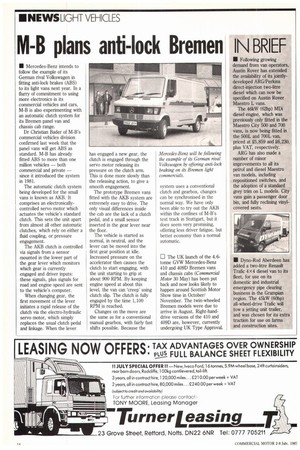M-13 plans anti-lock Bremen
Page 16

If you've noticed an error in this article please click here to report it so we can fix it.
• Mercedes-Benz intends to follow the example of its German rival Volkswagen in fitting anti-lock brakes (ABS) to its light vans next year. In a flurry of commitment to using more electronics in its commercial vehicles and cars, M-B is also experimenting with an automatic clutch system for its Bremen panel van and chassis cab range.
Dr Christian Bader of M-B's commercial vehicles division confirmed last week that the panel vans will get ABS as standard. M-B has already fitted ABS to more than one million vehicles — both commercial and private — since it introduced the system in 1981.
The automatic clutch system being developed for the small vans is known as AKB. It comprises an electronicallycontrolled servo motor which actuates the vehicle's standard clutch. This sets the unit apart from almost all other automatic clutches, which rely on either a fluid coupling, or pressure engagement.
The AKB clutch is controlled via signals from a sensor mounted in the lower part of the gear lever which monitors which gear is currently engaged and driver inputs: these signals, plus signals for road and engine speed are sent to the vehicle's computer.
When changing gear, the first movement of the lever initiates a rapid release of the clutch via the electro-hydraulic servo motor, which simply replaces the usual clutch pedal and linkage. When the lever has engaged a new gear, the clutch is engaged through the servo motor releasing its pressure on the clutch arm. This is done more slowly than the releasing action, to give a smooth engagement.
The prototype Bremen vans fitted with the AKB system are extremely easy to drive. The only visual differences inside the cab are the lack of a clutch pedal, and a small sensor inserted in the gear lever near the floor.
The vehicle is started as normal, in neutral, and the lever can be moved into the first gear position at idle. Increased pressure on the accelerator then causes the clutch to start engaging, with the unit starting to grip at about 900 RPM. By keeping engine speed at about this level, the van can 'creep' using clutch slip. The clutch is fully engaged by the time 1,100 RPM is reached.
Changes on the move are the same as for a conventional manual gearbox, with fairly fast shifts possible. Because the Mercedes-Benz will be following the example of its German rival Volkswagen by offering anti-lock braking on its Bremen light commercials.
system uses a conventional clutch and gearbox, changes can be synchronised in the normal way. We have only been able to try out the AKB within the confines of M-B's test track in Stuttgart, but it does seem very promising, offering less driver fatigue, but better economy than a normal automatic.
The UK launch of the 4.6tonne GVW Mercedes-Benz 410 and 4091) Bremen vans and chassis cabs (Commercial Motor 30 May) has been put back and now looks likely to happen around Scottish Motor Show time in October/ November. The twin-wheeled Bremen models were due to arrive in August. Right-handdrive versions of the 410 and 409D are, however, currently undergoing UK Type Approval.




















































































